Awaara (1951): the world's most popular movie?!
Publié le 22 Mai 2008
 “Oh World, I am a wanderer in your puzzle!” So sings Awaara, Raj the vagabond, as he leaves the prison, and winds his way through village streets and benevolent humanity, his newly found freedom and his good nature hiding the deep wounds of a wrecked childhood. “Don’t sin any more!” the warden had said, as he was sent out of jail. But his tragic fate is fixed: once a thief, always a thief. There’s no way out of crime for him, says Jagga his evil guru.
“Oh World, I am a wanderer in your puzzle!” So sings Awaara, Raj the vagabond, as he leaves the prison, and winds his way through village streets and benevolent humanity, his newly found freedom and his good nature hiding the deep wounds of a wrecked childhood. “Don’t sin any more!” the warden had said, as he was sent out of jail. But his tragic fate is fixed: once a thief, always a thief. There’s no way out of crime for him, says Jagga his evil guru.
Raj is thrown into the world only to wander from one misery to the next, from one loss to another: why is he thus chosen as God’s toy? He was born with a good heart, but is slave to the torment and horror of evil. Why is there no escape for him, no redemption? Where is the road to fulfilment, to happiness? Why must one hide and suffer, instead of being honest and loving? Is it a pre-ordained destiny? Several explanations are possible: there is perhaps a big Book somewhere, where our names are written in white or black, according to the whims of some inscrutable deity. There is the Marxist answer: Raj is the victim of class-struggle in which oppressive capitalists exploit the uneducated masses, and benefit from their ignorance and their powerlessness. Raj’s plight can also be looked at in terms of biological determinism: he’s born of a woman who hasn’t told him who his father is; he has no father, thus no honour; society cannot accept him.
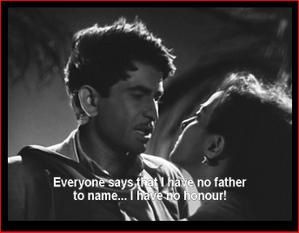
Whatever the explanation given to Raj’s story, the interest of the film is that it has a universality, an exemplarity that we can all refer to. Not all of us were born with a tragic origin, and not all of us were excluded and bullied. Some of us have even benefitted from a love and a care which is, we know, our most precious treasure. Still, there’s something profoundly human in Raj: perhaps because of his sad beginning in life, he has been made all the more aware of the anguish and the puzzle of life. Why were we born on this planet of woes and death? Who for? What for? Our human condition is an enigma that only living can make us conscious of. What is this life? Was it indeed made for love? What is love? Why do we destroy it when we should on the contrary cling to it with all our might? Where does this obscure attraction for violence and darkness come from? How can one escape from this Hell?
The superlatives surrounding this 1951 Raj Kapoor movie are a little arresting – most successful Bollywood film, even “most popular film of all times” (link)… I had watched it once, and coming as it did for me after and Shree 420 (1955) and Jagte raho (1956), I confess I was a little disappointed. So when I read about the movie’s stunning fortune in the Eastern block, in China, Turkey, and god knows where else, I started wondering: how come it was so successful? What struck the 1950s public as so fascinating? When crowds cheer to that extent, I always think there must be a reason! I decided to watch it again. And that’s when it worked! I had previously thought it was too preoccupied by effects (the special effects of the 1950s!), and that its artistic intention had perhaps been hampered by the impatient desire to demonstrate what the newly Raj Kapoor studios (not even finished: see here) were able to do. I thought it wanted to say too much; that it was weighed down by a certain demonstrative attitude, a certain experimentalism, that it didn’t lift itself out of that psychological and symbolical exercise, and just didn’t reach the skies of perfection I was hoping it would reach! Grace, that was what was missing.
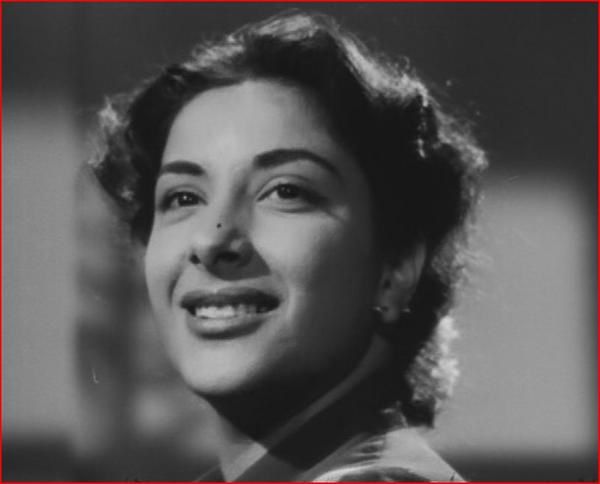
(Was I wrong?)
Well, while I can still see where the possible defects came from, I now overlook them (1). I am now touched by the film’s moving story, its rich symbolical message, its buoyant rhythm, and its daring imagery. There is enough sheer beauty in Awaara to muse for hours after one has seen it. And first, the Kapoor men’s radiant faces! The father, and his two sons are a real treat to watch, and I’m sure it’s not only the cameraman’s artistry! Then there’s Nargis of course (of course, but she’s occasionally stilted, and perhaps that’s part of the film’s disappointment?). Nevertheless, she is as pleasant to look at as ever. I enjoyed that famous scene on the boat, but perhaps as much for its symbolism as for its sensuality. The upside down and blurred views of the lovers, for instance: they made me wonder if Raj Kapoor (the director) had in mind the risks of drowning that love can run when it jeopardises everything in the name of passion. The beauty of love is that in essence it is radical, and doesn’t stop at wondering whether or not it can save loved ones from other radical dangers, but sometimes it is just not strong enough…
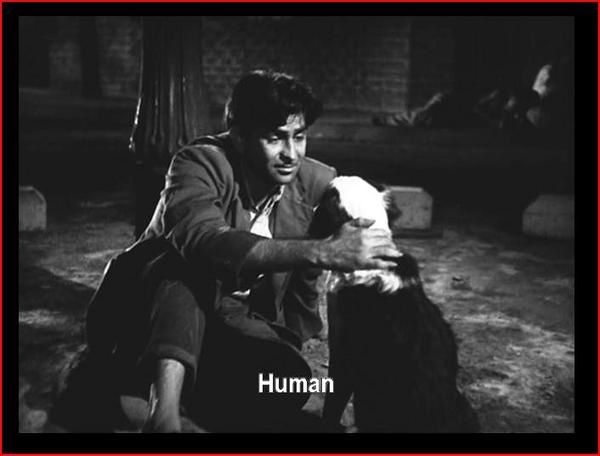
There is this very touching scene between Raj and another tramp, that dog he meets on the street, and to which he fondly explains that humans are animals that need friends, some warmth, a home: echoes of King Lear? Clever scene, because it takes place just after Raj has been thrown out of a job like a dog, and just before he jumps up and savagely (like a mad mongrel in fact) collars a passer-by who has brushed against him. He fights as much against the rude passer-by, as against the "savagery" he feels has exploded in him so easily. In this fight, which is so violent that we fear he might actually strangle the man, there is all the desperation at being so helplessly manipulted by his instincts and by the obscure social forces that have made him a outcast. And then he has a vision, this one:
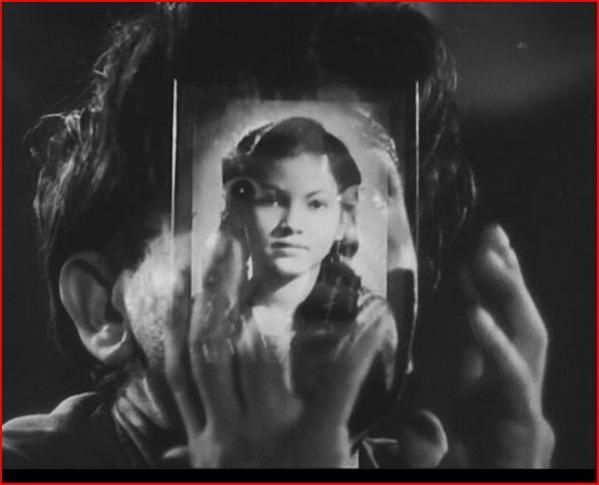 It's the visualisation of his tortured conscience, with Rita's childhood portrait, probably representing the humanity that love can bring to the soul. We see his frightened eyes behind, and the superposition captures the moment of realisation, which is also the moment of guilt and shock as to what men are capable of...Where is the border between humanity and animality? Does violence belong to humanity? Isn’t savagery, down deep, very human? (the death and torture camps of all ages are a strictly human invention - no animal can “think” in such a wild yet organised way) Of course we touch here the theme of nature vs. nurture, that all the commentaries on Awaara mention.
It's the visualisation of his tortured conscience, with Rita's childhood portrait, probably representing the humanity that love can bring to the soul. We see his frightened eyes behind, and the superposition captures the moment of realisation, which is also the moment of guilt and shock as to what men are capable of...Where is the border between humanity and animality? Does violence belong to humanity? Isn’t savagery, down deep, very human? (the death and torture camps of all ages are a strictly human invention - no animal can “think” in such a wild yet organised way) Of course we touch here the theme of nature vs. nurture, that all the commentaries on Awaara mention.
But I wonder whether the film really deals with this theme all that much. Of course, the Judge Raghunath (Prithviraj Kapoor) believes that bandits must be born of bandits, and that there is a social and biological predestination that blocks all progress, all moral improvement. This seems to be in keeping with the Indian caste system: tramps and gentlemen are thus forever separated. And Jagga (KN Singh), the dacoit whom Raghunath had once sent to prison, and who is intent on revenging himself, will visit his own sins on the judge’s son in order to prove him wrong. But no one really believes that this determinism really operates, do they? On the other hand, what we see is that trauma and suffering operate. The film is in that sense a psychological and social experiment, not a religious or philosophical one. What we see is shock, poverty, and suffering leaving their imprint on a child’s mind. Placed in a favourable environment, a normal child will thrive; but the same child will be blighted by violence and fear. Anyone who has read Dickens knows that story by heart. This Jagga is in fact a very Dickensian character! He’s a regular Fagin. And Awaara bears indeed not a little resemblance to Oliver Twist!
 Distrust and stealing are close cousins. Both attack other men’s integrity. Both take from them what should remain theirs. Trusting is indeed letting another person deal with herself the way she judges best. The judge cannot help distrusting his wife, and his son will be made to copy his distrust by becoming a thief. The poison of distrust is what makes the Judge reject his wife, who, like the famed Sita of the Ramayana (the film itself makes the point), is sacrificed to her husband’s compulsive code of honour. I am not much versed in Hinduism, but I half remember that in the saga, Rama is as desperate to let her go, as he is at the idea that she might have sinned. He chases her, and it hurts him as much as it does her. Perhaps the movie wishes to illustrate the mystery of this Necessity, and Hindus understand this as a religious reality that is not totally in our power to fathom. That would explain why there is such an insistence on predetermination in the film. For behind it, in it, there is something of the transcendent deity that doesn’t operate in a way humans would like it to operate. Naturally we Christians cannot accept such arbitrary injustice – well, at least, not that much (2). Jesus criticised the Jewish belief of the visitation of the father’s sins on his children, and said that a leper isn’t impure because he has sinned, but that his illness is a way for God to reveal his glory. Like distrust, ignorance is a thief: it steals men of their identity as God’s children, it makes them bear the heavy yoke of guilt. And both Marx and Freud are right to denounce this oppression, the victims of which are too often the poor and the fragile, for whom education is out of reach.
Distrust and stealing are close cousins. Both attack other men’s integrity. Both take from them what should remain theirs. Trusting is indeed letting another person deal with herself the way she judges best. The judge cannot help distrusting his wife, and his son will be made to copy his distrust by becoming a thief. The poison of distrust is what makes the Judge reject his wife, who, like the famed Sita of the Ramayana (the film itself makes the point), is sacrificed to her husband’s compulsive code of honour. I am not much versed in Hinduism, but I half remember that in the saga, Rama is as desperate to let her go, as he is at the idea that she might have sinned. He chases her, and it hurts him as much as it does her. Perhaps the movie wishes to illustrate the mystery of this Necessity, and Hindus understand this as a religious reality that is not totally in our power to fathom. That would explain why there is such an insistence on predetermination in the film. For behind it, in it, there is something of the transcendent deity that doesn’t operate in a way humans would like it to operate. Naturally we Christians cannot accept such arbitrary injustice – well, at least, not that much (2). Jesus criticised the Jewish belief of the visitation of the father’s sins on his children, and said that a leper isn’t impure because he has sinned, but that his illness is a way for God to reveal his glory. Like distrust, ignorance is a thief: it steals men of their identity as God’s children, it makes them bear the heavy yoke of guilt. And both Marx and Freud are right to denounce this oppression, the victims of which are too often the poor and the fragile, for whom education is out of reach.
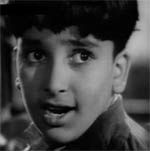
Education is naturally at the centre of the film: we see little Raj at the beginning being deprived his schooling because his social status has been discovered. So one would be tempted to say that Raj hasn’t received any education apart from the “special” one inflicted on him at the reformatory. This is why Rita calls him a “savage” (jinglee), in the scene at the beach, where he watches her dress. “Gentlemen” would not do that, she explains. But there is education and education: socially hypocritical upbringing, which transmits class prejudices, and real education, that of the heart and of the will. Raj was given the latter, thanks to his mother (Leela Chitnis). Witness the very beautiful scene where he lies to her about the food that she believes - because she’s ill - she has prepared for him, but doesn’t exist. His true regard for her expresses itself here, in a very adult fashion. His mother represents (as always in such films) constant goodness and virtue. She’s the one Raj runs to, when he realises the hell he’s been living in:
“Ma, I want to be good! I will not steal any more! I want nothing but my peace of mind and my mother’s blessings:”
Raj has been educated by her love. If he has become a human being and not an animal, it’s thanks to her. Love educates, love turns the human creature born in this world into a being capable of civilised feelings: justice, forgivenesss, selflessness, and the hope that humanity can evolve away from violence and absurdity. So in fact Raj’s nature has been educated, has been civilised. What happens to him through Jagga (and originally, through his father’s crime, that Jagga reverberates) is not a lack of education, but the blow coming from the old Evil, the primeval violence, the original sin of mankind killing mankind, not recognising (or worse, refusing) in another man’s face the presence of God who inhabits him.
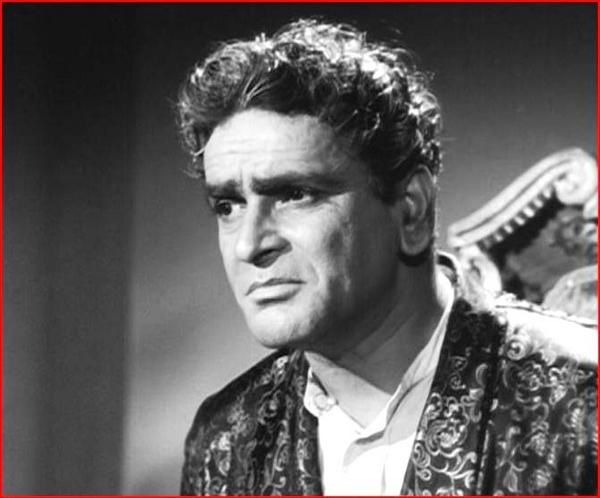 At one moment Raj enters Rita’s house for the first time, dressed up as a gentleman, and thus hidden (for her) behind a disguise. This is what he tells her:
At one moment Raj enters Rita’s house for the first time, dressed up as a gentleman, and thus hidden (for her) behind a disguise. This is what he tells her:
“Real thieves dress up in first class suits like I’m wearing, and we take them for gentlemen. But those who work hard for an honest living, and dress shabbily, are labelled tramps and wastrels. The capitalists, the black-marketers, the profiteers, the usurers, who are they? Thieves, like I am!”
The irony of the scene is that of course, Rita is ignorant at the time of Raj’s real situation. So that his speech has in fact two targets: the rich who steal lawfully by exploiting the poor; and the social code used to denounce them: language. Indeed human language, that complex tool crafted to establish a connection between ideas and reality (truth is the adequacy of the two) is corrupted; it is powerless to extract itself from a double standard of truth, and an accusation can always be thought a joke, if the accused chooses not to hear this accusation. This is what Rita does, even if she naïvely cannot comprehend that there is a fundamental injustice in being so rich and living in such a luxurious mansion.
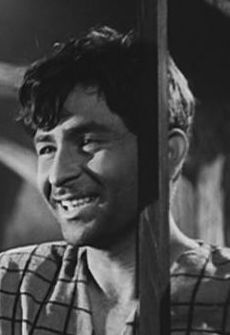
So all in all, Awaara is a social and moral fable, much like Shree 420: let’s say it is more social, and Shree more moral, in the sense that the latter really puts forward the question of free choice in front of good and evil. Awaara focuses more on the human condition, its potential absurdity but also its uncanny beauty, its puzzling reality. I really marvel at Raj Kapoor’s ability to create movies in which such symbolical stories are merged with such idealism and creativity. This man is a true poet.
PS: I have reserved some additional comments about the renowned dream-sequence for a further post. Wait for it !
January 2012: An interesting comment on the religious symbolism of the film can be found here: link
And here's another review on the role of the father figure (embodied here by Prithviraj) and the subsequent angry young man revolution: link
Finally, here Pessimisissimo comments on the possible influence of Carousel (based on Ferenc Molnár's 1909 play Liliom) on Awaara.
(1) I even thought at one stage that the film’s success in Asia came from its leftist stance. That it was a feel-good proletarian story that vindicated the rights of the oppressed and condemned the pride of the rich higher classes. And, what is essential, this product was available, outside the American arch-enemy in a developing nation that had a cinema industry of its own. The socialist countries seized it as a popular form of art with which to press down their anti-capitalist message. There was some ground for what I thought in the article which I quote above:
Raj Kapoor’s early films were extremely popular in Soviet Russia. These were the first Indian films to be screened in Russian cinemas, as a prelude to Prime Minister Nehru’s first visit to the former Soviet Union. Most of the films being made in the Soviet Union were heavy propaganda films. Raj Kapoor’s films presented almost the same pro-poor, pro-working class “propaganda” – but in such imaginative and splendid settings that the Russians were mesmerized.
(2) There is an authentic strain of thought in Christianity for which God’s justice is inscrutable, because God justifies who he wishes to justify, and we cannot decide who he saves or who he doesn’t save. This strain can of course be exaggerated. It has, in fact, many times, for example in Jansenism.
/image%2F1489169%2F20200220%2Fob_9722d6_banner-11.JPG)